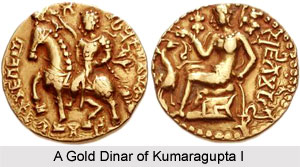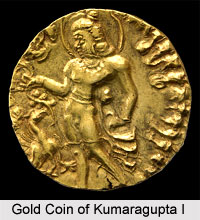 Kumaragupta I succeeded his father Chandragupta II to power about 415 A.D., and ruled fairly for a long period of 40 years till 455 A.D. Kumaragupta was the son of Chandragupta II by his chief queen Dhruva Devi. According to contemporary literary evidences and the Vaishali Seal and Mandasor inscription, Kumaragupta I did not have a smooth and undisputed succession to the throne. In Vaishali Seal it is inscribed that Govinda Gupta, the eldest son of Chandragupta II, ascended the throne after the death of his father. Dr Bhandarkar also supports the theory and puts forth that in the short intervening period after Chandragupta II`s death and the ascension of Kumaragupta I, Govinda Gupta sat on the throne of the Gupta lineage. Furthermore Dr. Bhandarkar adds that, Kumaragupta I ascended the throne after the sudden death of Govinda Gupta, the immediate successor of Chandragupta II. But the modern scholars discard the theory of Dr. Bhandarkar that Govinda Gupta was the immediate successor of Chandragupta II. They have cast-off the theory on the grounds that the name of Govinda Gupta is not found in the Gupta genealogical list. Moreover the inscription on the Vaishali seal does not throw much light on the identity of Govinda Gupta and his relation with Kumaragupta I. According to modern scholars, Govinda Gupta might have been the governor of Vaishali province, who rebelled against the Gupta king Kumaragupta I. However, the generally accepted theory is that Kumara Gupta inherited the throne of his father Chandragupta II after his death and continued to be the king of ancient India for a lengthy period of forty years.
Kumaragupta I succeeded his father Chandragupta II to power about 415 A.D., and ruled fairly for a long period of 40 years till 455 A.D. Kumaragupta was the son of Chandragupta II by his chief queen Dhruva Devi. According to contemporary literary evidences and the Vaishali Seal and Mandasor inscription, Kumaragupta I did not have a smooth and undisputed succession to the throne. In Vaishali Seal it is inscribed that Govinda Gupta, the eldest son of Chandragupta II, ascended the throne after the death of his father. Dr Bhandarkar also supports the theory and puts forth that in the short intervening period after Chandragupta II`s death and the ascension of Kumaragupta I, Govinda Gupta sat on the throne of the Gupta lineage. Furthermore Dr. Bhandarkar adds that, Kumaragupta I ascended the throne after the sudden death of Govinda Gupta, the immediate successor of Chandragupta II. But the modern scholars discard the theory of Dr. Bhandarkar that Govinda Gupta was the immediate successor of Chandragupta II. They have cast-off the theory on the grounds that the name of Govinda Gupta is not found in the Gupta genealogical list. Moreover the inscription on the Vaishali seal does not throw much light on the identity of Govinda Gupta and his relation with Kumaragupta I. According to modern scholars, Govinda Gupta might have been the governor of Vaishali province, who rebelled against the Gupta king Kumaragupta I. However, the generally accepted theory is that Kumara Gupta inherited the throne of his father Chandragupta II after his death and continued to be the king of ancient India for a lengthy period of forty years.
Epigraphic records, contemporary to the period of Kumaragupta, are the extant sources from which the facts about the reign of Kumaragupta I can be known. There are about 13 epigraphic records assigned to the period of Kumara Gupta I. The records speak of the able governmental organisation and sound administration of Kumaragupta I. After the ceaseless conquest of his predecessors for three quarters of a century, Gupta Empire had its well-earned rest and the consolidation under Kumaragupta I. The vast Imperium Kumaragupta I inherited from his father was kept intact by him for a period of forty years. Under him the Gupta Empire reached its zenith and to celebrate the glory and prosperity of the realm, he performed the Ashwamedha Yajna. According to scholars, the very execution of the Ashwamedha Yajna testifies the undiminished glory of the Brahmanical culture of the Gupta Empire. However there is a controversy among the scholars about the causes behind the performance of the Ashwamedha Yajna. A stash of coins belonging to Kumaragupta I has been discovered in the Satara district of Maharashtra and also in Ilichpore districts of Berar. This points towards the extension of the Gupta Empire upto the limits of Deccan. According to scholars, Kumaragupta I`s victory in Deccan led him to a majestic completion of the Ashwamedha Yajna. That Kumaragupta I invaded some portions of south India is evident from his coins. It has also been suggested by scholars that though Kumaragupta was engaged in the consolidation of the Empire, yet the Gupta alliance with the Vakatakas declined during the reign of Kumaragupta I. During that time Kumaragupta had established an alliance with Bhabadatta Varmana of the Nala dynasty. However according to scholars, the Deccan campaign of Kumaragupta I was spurious, since no conclusive epigraphic evidences support it.
 From the epigraphic records of the reign of Kumaragupta it is known that Kumaragupta had instituted a strong foundation of the provincial administration. The Gupta Empire during the reign of Kumaragupta I was divided into several provinces. Records of Kumaragupta have been found in the regions of Dinajpur and Rajshahi regions of Bengal, which indicates Bengal as one of the provinces of the Gupta Empire during Kumaragupta`s sovereignty. The regions of Malwa and Mandasor were also important provinces under the Gupta Empire. Kumaragupta had maintained a strong provincial administration by appointing efficient and competent people as governors of those provinces. These governors were responsible to the king and Kumaragupta himself kept a watchful eye on the proper maintenance of provincial administration.
From the epigraphic records of the reign of Kumaragupta it is known that Kumaragupta had instituted a strong foundation of the provincial administration. The Gupta Empire during the reign of Kumaragupta I was divided into several provinces. Records of Kumaragupta have been found in the regions of Dinajpur and Rajshahi regions of Bengal, which indicates Bengal as one of the provinces of the Gupta Empire during Kumaragupta`s sovereignty. The regions of Malwa and Mandasor were also important provinces under the Gupta Empire. Kumaragupta had maintained a strong provincial administration by appointing efficient and competent people as governors of those provinces. These governors were responsible to the king and Kumaragupta himself kept a watchful eye on the proper maintenance of provincial administration.
However the peaceful foundation of the consolidated Gupta Empire was violently disturbed due to the invasion of the powerful enemy, whose identity is still not definitely established. That the Gupta Empire in the dying days of Kumaragupta`s reign was threatened by alien invasion is certain, because it is supported by various literary and epigraphic records of the contemporary age. According to Fleet, these hostile forces belonged to a tribe called the Pushayamitras. The view of Fleet is corroborated by the Bhitari Pillar inscription of Skandagupta, where he mentioned that his father`s kingdom was invaded by a tribe called Pushayamitras. The name Pushyamitra on the inscription was little mutilated. Hence scholars have proposed a different meaning of the name. It is suggested that the word should be named as "Yudhyamitra" and not "Pushyamitra". But this alternate reading is discarded by a majority of scholars. Fleet and other scholars hold that the rivalry of the Guptas with the Vakatakas was the result of the Pushyamitra invasion. The expansionist policy of Kumaragupta I was responsible for the violent invasion of the Guptas. The Pushayamitras became the allies of Narenderasena of Vakataka with whom the Guptas were extremely hostile. With the aid of Narendra, the Pushyamitras invaded the Gupta Empire. The Bamnal horde of the Gupta coins discovered towards the south of Narmada with the image of gold bars, testify the political unrest in the region due to the invasion of the Pushyamitras. It is also inscribed in the Bhitari Stone Pillar inscription of Skandagupta about the political unrest during his father`s reign. The invasion of the Pushyamitras injected grave menace within the Empire, which ultimately brought about the downfall of the Guptas.
The reign of Kumaragupta appeared to be dull and unattractive in the backdrop of the brilliant reign of his predecessors. But it marks the climax of the Gupta power. His inscriptions throw light on the attributes of Kumaragupta as an administrator. He worked for the welfare and material prosperity of his subjects. The Bhilsar inscription refers to the institution of "Satra" for distributing drinking water to the passersby. The "Gadhoa inscription" shows that Kumaragupta had donated villages for the maintenance of the "Satras". He had built the Kartikeya temple in Bhilsar and the Udayagiri inscription refers to the foundation of the statue of Jain Tirthankara. The king also granted lands and loan to the poor and made offerings to the Brahmanas. Such a just and benevolent king Kumaragupta expired in 455 A.D., which marked the beginning of the decline of the Gupta Empire. Although Kumaragupta did not win any battle like his predecessors, yet he is the only one who has the credit of ruling for a period of 40 years. The military machinery of the Guptas did not lose its efficiency during the peaceful reign of Kumaragupta I. It was only after the downfall of Kumaragupta that the Gupta Empire witnessed a total collapse of their vast integrity.






































